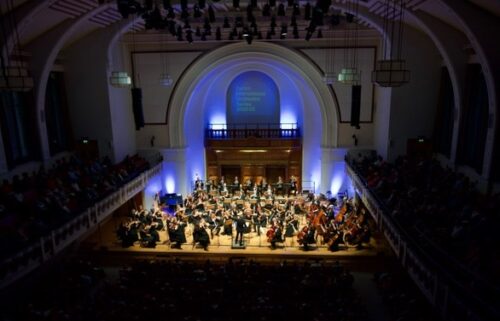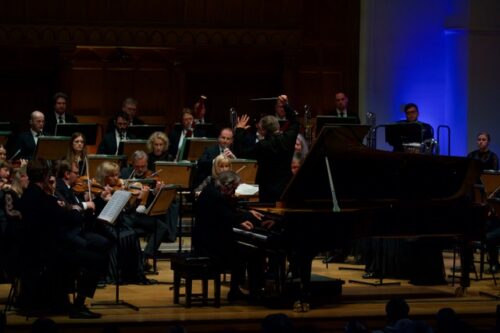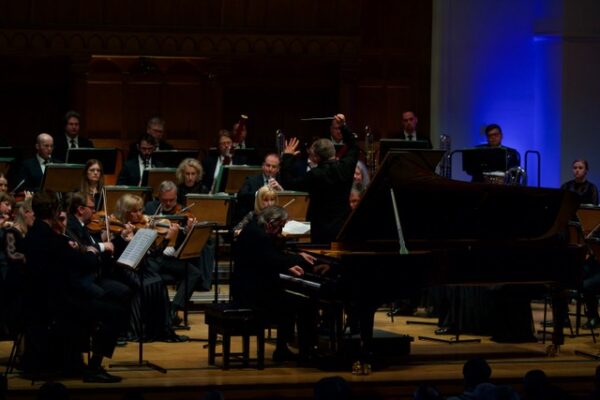 United Kingdom Pärt, Rachmaninoff, Musgrave, Sibelius: Barry Douglas (piano), Estonian National Symphony Orchestra / Olari Elts (conductor). Cadogan Hall, London, 24.5.2023. (MBr)
United Kingdom Pärt, Rachmaninoff, Musgrave, Sibelius: Barry Douglas (piano), Estonian National Symphony Orchestra / Olari Elts (conductor). Cadogan Hall, London, 24.5.2023. (MBr)

Arvo Pärt – Cantus in Memoriam Benjamin Britten
Rachmaninoff – Piano Concerto No.3
Thea Musgrave – Song of the Enchanter
Sibelius – Symphony No.5
This concert, the final one of the current season of the Zurich International Orchestra Series at Cadogan Hall, was a superb program. But this has been entirely characteristic of all the concerts I have been to; there has been no Beethoven or Brahms, although had this series gone on any longer I might well have heard an entire Sibelius symphony cycle.
The orchestras have been ones we rarely hear in the United Kingdom, and they have been excellent – the Estonian National Symphony Orchestra being no exception to previous ones. Given this Tallin-based orchestra’s location it is perhaps not a surprise that the program should have included music from Estonia, Finland and Russia – with a nod also to its visiting country, Britain. This orchestra may well find its origins rooted in three very different geographical, social and historical traditions but it has a sound that is perhaps most notable in the strings with their gorgeous warmth, rounded depth and tone; for my taste, however, I felt both the woodwind and brass inclined more towards a Russianness and neither felt quite so comfortable in the Cadogan Hall’s acoustic. This is a venue – much like Wigmore Hall – where detail and sound are in perfect alignment and not all orchestras or soloists naturally benefit from it.
The strings were, however, the focus of the first work, Arvo Pärt’s Cantus in Memoriam Benjamin Britten. Quite a marvellous piece for this hall, it also happened to be the finest performance of the work I have yet heard live – and remarkably similar to this orchestra’s recording on Virgin Classics with Paavo Järvi. It is easy to see why this work has the same common, popular appeal as a piece like Samuel Barber’s Adagio for Strings – although it is also easy to see why both works are also uncommonly good ones for strings. There is, of course, one major difference – Barber’s was never intended to be a piece of music about mourning (but has become universally symbolic of it) whereas Pärt’s was specifically written in dedication to the death of Benjamin Britten.
Complexity is one thing that is generally elusive in Pärt’s music so what could be simpler than a work based entirely around a single tonal centre – in this case the A minor scale. Cantus opens with the funeral bell symbolising Britten’s death (struck at intervals throughout the work). Half the first violins begin on pianississimo on the descending A minor scale; the second half of the violins at a lower pitch. Second violins play an octave lower, although at half the tempo, violas an octave lower and at quarter the speed, cellos another octave lower and one eighth the speed and eventually basses at one sixteenth. Once the first violins have reached middle C they simply play on the open string for the rest of the work until eventually the basses have reached their own low A and all the strings are playing at fortississimo. The strings shudder to a halt and the tubular bell is struck at pianissimo, its reverberation echoing into total inaudibility.
Simple perhaps – but performances require something at least a bit more complex. Playing this music for six or so minutes is just never going to be enough, and I have rather despaired in the past of sitting through performances that have neither balanced the strings, nor got the tintinnabulatory effect of the music right. Conductor Olari Elts managed both, but he brought intensity to the playing as well – the sheer depth, glow and singularity of that long C on the violins was so in unison, so majestic, it was just opulent to listen to. The cellos, imperceptible at first, became dark and rich the more they grew to a fortissimo. The was string playing as burnished and hauntingly toned as I remember from one given by the St Petersburg Philharmonic.

Rachmaninoff’s Third Piano Concerto was the second work on the program, although the suggested running time of 39-minutes was a little wide of the mark, even if the performance itself never once hung fire. One Tchaikovsky Piano Competition medallist (Barry Douglas) replaced another (Freddy Kempf) – although this had been advertised for several months – but no one would have been disappointed with the performance that Douglas delivered. I am not especially a fan of his style of playing – he can sometimes sound a little remote, cold, and I often see too much black and white in his interpretations. This works for some music; not for others – and not, I think, for Rachmaninoff. This was by no stretch anywhere close to the most poetic account of this concerto I have heard, and I sometimes felt, especially in the third movement, that he didn’t come near enough to projecting lucid contrast in the score. On the other hand, the brilliance of the playing, the virtuosity, the peerless control of the keyboard was simply outstanding.
Douglas’s Rachmaninoff comes closest to the Martha Argerich approach (one I don’t warm to very much in this concerto) rather than that of Santiago Rodriguez (which I do). Neither of those pianists play the long cadenza in the first movement; Douglas does (and did in this performance) and it felt rather a breeze for him to do it. He took a slightly similar approach to Argerich in the third movement cadenza (though without her lack of keyboard control) in that he was less inclined to apply anything to the molto marcato – it really felt like a straight run down the keyboard. Douglas was certainly not alone in lacking rubato in the meno mosso passage at Reh.52 (unlike Rodriguez who is exquisite here). Likewise, the three notes before Reh.62 Rachmaninoff marks with both a staccato and an accent; for Douglas they appeared to have neither.
The performance was at its best when Douglas needed the power to drive through it – and he had oodles of power. The sheer sound was formidable – the climax to the second movement being notably so (the low right hand D flat before the first one almost tolling like a bell). Octaves were formidably accurate. Elts kept the Estonian Symphony Orchestra remarkably well together in a concerto where soloist and orchestra can often find themselves on quite different trajectories. If this performance felt a little old-fashioned, it was because virtuosity came before any real attempt to play the work as a poetic masterpiece. It was in many ways remarkable; it was unquestionably thrilling. But it was also rather prosaic – perhaps entirely the version of this concerto many wanted to hear, but not one that felt visionary or expressive. Great performances come in many forms; as divisive as this one felt, it never really felt less than great for many of those who heard it here.
Thea Musgrave’s Song of the Enchanter opened the second half of this concert – and its link to the final work, Sibelius’s Fifth Symphony made it organically appropriate. It’s such a Sibelian work – if you didn’t know it was Musgrave you would think the work might indeed be Finnish – it quotes from the symphony directly – notably from the ‘Swan Theme’. It is a brooding, haunting piece, beautifully written; and evocative of the Sibelian landscape, especially in the use of timpani. The playing was superb – strings were heavy with a stormy darkness, the tam-tam rolled like thunder.
Sibelius’s Fifth is one of his most compressed symphonies (although not as much as the magnificent Seventh). For the first time in this concert it was the Estonian brass which were in the spotlight – the symphony opens, after all, on the horns. Not the easiest of beginnings, and not the safest here either – with neither enough softness to the touch nor enough smoothness to the tone. They were better in the first theme – along with a characterful, buoyant bassoon – and a gorgeously phrased tremolo on the strings. Elts clearly understood the rhythms, and the separate but tied-in tempo in the first movement – so we got a scherzo which was as pervasively melodic as it was sharply played; timpani nailed the dots here with absolute precision. The coda – at a swift più presto felt swift, but justly so.
The Andante mosso can sometimes feel loose, but Elts gave it a tightness that meant the melody of the main theme (played beautifully here on the flute) had a taut clarity of authentic bird chirping beside the string pizzicatos. Cellos and basses had just enough bloom to evoke the beginning of the ‘swan’ theme that is to become dominant during the final movement. The Allegro began on wonderful tremolo strings, the swan itself on horns playing in triple time, as elegantly done as the curve in their necks and with the delicacy and refinement of their feathers – the melody itself rapturously played on flutes and strings. The final bars came, with six jagged chords, shattered only by uneasy silence, and played with unnerving clarity.
The one encore, Sibelius’s Melisande’s Death, was astonishing for both its sheer elegance of phrasing and dramatic impact. An encore than managed to capture in its miniature length a concert that had been ambitious in scale and magnificent in effect.
Marc Bridle

Thank you; it was a fine concert. There were actually two encores: as in Perth they did a Tubin dance. In Birmingham it was just one encore, again the Sibelius, though after a great Dvorak 7 (the Rach 3 there was almost unbearable as the Steinway was so harsh & clattery..much better in smaller Cadogan Hall, oddly.
Thanks for confirming the Sibelius encore piece. Also in Birmingham Symphony Hall we were treated by Barry to a wonderful surprise piano solo encore of Prokofiev’s Montagues and Capulets – and the audience loved it.
We did! In London he played one of Tchaikovsky’s ‘Seasons’.
Many thanks for the added information on the encores. It didn’t look like there would be a second one at the London concert – but clearly I was wrong about that. As regards the Douglas encore after the Rachmaninoff, the Tchaikovsky slightly threw me since I am not familiar enough with the work to know which of the twelve it was. I, therefore, decided not to mention it.
It’s interesting that in Birmingham they played Dvorak 7 – an absolute masterpiece of a symphony. That would have been great to hear, but I do sometimes wonder whether the size of the Cadogan Hall platform makes some symphonies more possible to play than others (although in this case Dvorak 7 and Sibelius 5 are virtually scored identically).
It does, however, sound as if they need a better Steinway in Birmingham.